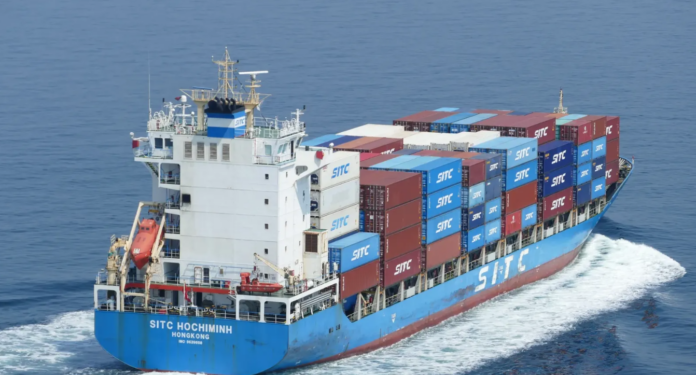Stay updated on Vietnam Container Shipping as SITC and ASL adjust key shipping routes in 2025, impacting ports in Ho Chi Minh City, Da Nang, and Haiphong.
Vietnam Container Shipping: SITC Adjusts Japan-China-Thailand-VN ‘VTX2’
Chinese regional carrier SITC, also known as Shanghai International Transportation Corporation, has recently announced significant adjustments to its Japan-China-Thailand-Vietnam ‘VTX2’ shipping loop. This restructuring aims to enhance operational efficiency, improve service reliability, and better align with shifting trade demands in the dynamic Asian market. The adjustments reflect the carrier’s continuous efforts to optimize its regional shipping network while responding to evolving logistics and trade flows.
Vietnam Container Shipping – Key Route Changes in the ‘VTX2’ Loop
As part of these changes, SITC will remove the Thai ports of Bangkok and Laem Chabang from the rotation, along with one of its northbound calls at Ho Chi Minh City. The decision to eliminate these stops is likely driven by factors such as evolving cargo demand, port congestion, and the need to streamline transit times. In place of the removed ports, SITC will introduce new calls at Hong Kong and Da Nang on the southbound segment of the loop. This adjustment strengthens the company’s service offerings, providing enhanced connectivity for businesses trading between Japan, China, Vietnam, and Hong Kong.
With Da Nang now integrated into ‘VTX2,’ SITC has decided to remove the Northern Vietnamese port from its Japan-China-Vietnam ‘CJV7’ loop, effectively consolidating its Vietnam operations under a single network. Additionally, the company has made modifications to its ‘VTX1’ loop, eliminating the northbound Bangkok call and one of the two Laem Chabang calls, reflecting a broader strategic shift in its Southeast Asian operations.
New Rotation Schedule and Service Commitment
Despite removing Thailand from the ‘VTX2’ loop, SITC remains committed to facilitating trade between Thailand and China. The carrier will continue offering four weekly sailings between Central China and Thailand, ensuring stable and efficient shipping connections. Furthermore, SITC will maintain its two weekly loops—‘VTX1’ and ‘VTX3’—which provide direct trade routes between Japan’s Kanto and Chubu regions and Thailand. These alternative services reaffirm the company’s presence in the Thai market while allowing it to optimize other trade lanes.
The updated ‘VTX2’ will maintain a four-week rotation, utilizing four 1,800 TEU vessels. The revised port rotation includes Nagoya, Tokyo, Yokohama, Shanghai, Ningbo, Xiamen, Hong Kong, Da Nang, Ho Chi Minh City, Ningbo, Shanghai, and back to Nagoya. This structured rotation ensures regular and reliable shipping schedules, helping businesses plan their supply chains more effectively.
The first vessel to operate under this revised itinerary will be the 1,808 TEU SITC LIAONING, which is scheduled to depart from Nagoya on 7 March. This update marks a strategic realignment for SITC, enhancing its presence in key trade corridors while adapting to the evolving demands of regional and international shipping.
SITC : ‘VTX2’Japan – China – Vietnam |
| Vessels Deployed |
| 4 x 1,800 teu |
| Port Rotation |
| Nagoya, Tokyo, Yokohama, Shanghai, Ningbo, Xiamen, Hong Kong, Da Nang, Ho Chi Minh City, Ningbo, Shanghai, Nagoya |
Vietnam Container Shipping: ASL Organizes China – VN – Philippines Loop
According to information from AXS, Asean Seas Line (ASL) has recently reinstated its China–North Vietnam ‘HHX1’ service, now integrated with a newly introduced China–Philippines segment, named ‘SVP2.’ This strategic adjustment underscores ASL’s continued expansion in the intra-Asia shipping market, aimed at strengthening trade connectivity across key economic hubs in China, Vietnam, and the Philippines. By restructuring its service network, ASL seeks to enhance operational efficiency, accommodate growing trade volumes, and provide more consistent shipping options for businesses in these regions.
Vietnam Container Shipping – New Service Integration and Operational Details
The newly combined ‘HHX1 + SVP2’ service operates on a three-week rotation, deploying three vessels with capacities ranging from 1,100 to 1,200 TEU. The updated port rotation includes Ningbo, Shanghai, Xiamen, Haiphong, Qinzhou, Nansha, Xiamen, Manila, and back to Ningbo. This rotation is designed to ensure smooth cargo flow between key manufacturing and commercial centers, enabling faster transit times and improved supply chain efficiency. While the official itinerary initially listed Hong Kong and Da Nang as ports of call, ASL has temporarily suspended these stops due to operational constraints, which may include port congestion, demand fluctuations, or logistical challenges. However, ASL may revisit these calls in the future based on market conditions.
Network Adjustments and Service Withdrawals
In parallel with these changes, ASL has made further adjustments to its service network by discontinuing its China–Japan ‘PJX2’ loop, which was previously operated by the 1,096 TEU vessel STRAITS CITY. The decision to halt this service reflects shifting market priorities and ASL’s focus on optimizing its most in-demand trade lanes. Additionally, the carrier is set to terminate its China-Malaysia-Indonesia-Vietnam ‘CPM’ service, with the final voyage scheduled to take place on 8 March at Xiamen, operated by the 1,182 TEU vessel CA OSAKA. This move is part of ASL’s broader efforts to streamline operations and redeploy resources to more strategic routes.
Alternative Service Arrangements for the Indonesian Market
Following the withdrawal of ‘CPM,’ ASL will no longer deploy its own vessels directly to Indonesia. However, the company remains committed to maintaining its presence in the Indonesian market by securing slot agreements on CNC’s (the intra-Asia arm of the CMA CGM group) ‘KCS’ service. This alternative route will ensure continued access to Indonesia’s major ports, including Jakarta and Surabaya, which are vital trade gateways for businesses operating in Southeast Asia. By leveraging partnerships and slot-sharing agreements, ASL can continue to serve its customers efficiently while optimizing costs and improving overall service reliability.
These recent network adjustments highlight ASL’s ongoing commitment to enhancing intra-Asia trade routes, ensuring flexibility in its operations, and adapting to the ever-evolving demands of regional and global shipping markets.
ASL : ‘HHX1 + SVP2’China – Vietnam – Philippines |
| Vessels Deployed |
| 3 x 1,100 – 1,200 teu |
| Port Rotation |
| Ningbo, Shanghai, Xiamen, Haiphong, Qinzhou, Nansha, Xiamen, Manila, Ningbo |
Cre: NovastarVN




